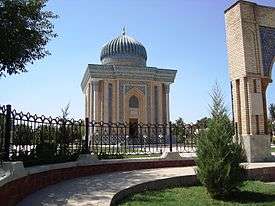Rahmatullah Kairanawi
Rahmat Allâh Kairânawî(رحمت الله الكيراناوي) (93–1818), also spelt or known by names Rahmatullah Kairanvi or Al-Kairanawi or Sheik Rahmat Kairanawi or Rahamatullah ibn Halil al-Utmani al-Kairanawi or Al-Hindi, was a Sunni Muslim scholar and author who is best known for his work, Izhar ul-Haqq.[2]
Rahmatullah Kairanawi رحمه الله | |
|---|---|
| Title | Kairanawi |
| Personal | |
| Born | Rahmatullah |
| Died | |
| Religion | Islam |
| Nationality | Indian |
| Ethnicity | Indian |
| Era | 19th century |
| Region | Uttar Pradesh, India |
| Denomination | Sunni, |
| Jurisprudence | Hanafi |
| Movement | Deobandi |
| Main interest(s) | Debate against Christianity |
| Notable work(s) | Islamic Social Reform during the 19th century, Debate against Christianity or Unislamic Innovations in Islam, Founder of Madrasah as-Sawlatiyah, |
| Tariqa | Chishtiya |
| Occupation | Muhaddtih, Faqeeh, Historiographer |
| Muslim leader | |
Influenced by
| |
Influenced
| |
Background
Kairanawi was born in Kairana of Uttar Pradesh, India during the last years of the Mughal Empire. He is a descendant of the third Caliph, Uthman ibn Affan, his full lineage is mentioned in family sources.[3] Part of the family wealth, a large property in Kairana, was granted by Akbar the Great.[3] Many family members held high positions and/or were intellectuals. Sheikh Hakeem Abdul Kareem who was an 8th great grandfather of Rahmatullah was the Emperor Akbar's physician. Kairanawani began receiving traditional Islamic education at the age of 6, memorizing the Qur'an at 12.[3] He also learned Arabic and Persian. Later he moved to Delhi where he studied different disciplines including mathematics and medicine.[3] Working as a Mufti and Sharia teacher, he founded a religious school in Kariana.[3][4]
Debate with Pfander
In 1837 the Church Mission Society appointed Karl Gottlieb Pfander, described by Eugene Stock as "perhaps the greatest of all missionaries to Mohammedans",[5] to Agra in Northern India, where in 1854 he engaged in a famous public debate with leading Islamic scholars. The main Muslim debater was Kairanawi[6][7], being assisted by English-speaking Muhammad Wazîr Khân and influential Islamic writer Imad ud-din Lahiz.[8] Kairanawi used arguments from recent European theologically critical works that Pfander was unfamiliar with, having left Europe before these were published, though his main source of reference was the apocryphal sixteenth-century Gospel of Barnabas, which he held to be authentic.[9]
Indian Rebellion of 1857
Following armed uprisings against the British in which he personally took part, Kairanawani (his property was confiscated by the Imperial British Raj) had to leave all his property (auctioned later), and board a ship in Bombay. Arriving at the port of Mocha, Yemen, he walked to Mecca. The journey took two years.[3]
Author
Kairanawi wrote books in Arabic, Persian and Urdu.
Izhar ul-Haq (Truth Revealed)
Written originally in Arabic, this book in six volumes was translated later into Urdu, and from Urdu into a summarized English version[10] published by Ta-Ha. The book aims to respond to Christian criticism of Islam. It is the first Muslim book to use Western scholarly works in order to ascertain the errors and contradictions of the bible. The doctrine of Trinity is purportedly contested using biblical, Christian and other sources. Christine Schirrmacher, a German scholar of Islamic Studies, states in an article on the Pfander-Kairanawi debate: "The Demonstration of the Truth' (izhâr al-haqq) served as a summary of all possible charges against Christianity and was therefore used after al-Kairânawî's death as a sort of encyclopaedia since al-Kairânawî extended the material of former polemicists like 'Ali Tabarî, Ibn Hazm or Ibn Taymiyya to a great extent."[8]
The Madrasa Sawlatia
While residing in Mecca, Kairanawi founded a religious school there. Rahmatullah Kairanawi was appointed as a lecturer at the Masjid-e-Haram by the Sheikh-ul-Ulama (The Leading Scholar) Sheikh Ahmad Dahlan As-Shafiee. Kairanawi started teaching and realized that lessons were delivered as sermons, rather than, planned academic lectures. He gathered some of the Indian Muslim immigrants, wealthy benefactors to establish an authentic Islamic Law School to teach the Islamic sciences through a sound curriculum. He established the Madrassah in 1290 hijrah corresponding to 1874 A.D. The major contributor was a lady of Calcutta by the name of Sawlat-un-Nisa, on whose name the Madrassah is named. The Madrassah is still in existence and has well known alumni around the world. Madrasah as-Sawlatiyah.[11] [12] [13]
References
| Arabic Wikisource has original text related to this article: |
- https://www.arabnews.com/node/400479
- Ramezannia, Mehrdad. Persian Print Culture in India, 1780 - 1880. Chapter 6: Jawaharlal Nehru University-Shodhganga. p. 235. Retrieved 26 March 2020.CS1 maint: location (link)
- Sheikh Abd-ur-Rahman Gazruni is a forefather of Rahmatull Kairanawi who was the military Chief Justice in Mahmood Ghaznavi Armies.Abd-ur-Rahman Gazruni is buried near the Panipat fort. (Qur'an se Bible Tak) Kairanvi Biography in Arabic Archived 27 September 2007 at the Wayback Machine, Madrasa Saulatia website.
- Bible se Qur'an tak
- Beginnings in India, chapter VIII, by Eugene Stock, D.C.L.; London: Central Board of Missions and SPCK, 1917.
- Parveen, Shabnam. Sir Syed Ahmad Khans contribution to Islamic learning. Chapter 4: Aligarh Muslim University. p. 81. Retrieved 26 March 2020.CS1 maint: location (link)
- Parveen, Shabnam. Sir Syed Ahmad Khans contribution to Islamic learning. Chapter 4: Aligarh Muslim University. p. 93. Retrieved 26 March 2020.CS1 maint: location (link)
- Schirrmacher, Christine. "The influence of German Biblical criticism on Muslim apologetics in the 19th century", Contra Mundum, 1997. Accessed 27 September 2007.
- Stock, The History of the Church Missionary Society its Environment, its Men and its Work (London, 1899–1916), 2: 171
- http://www.islam4all.com/newpage81.htm
- Kairana http://www.kairana.net/kairanvi-arbi.html. Missing or empty
|title=(help) - Nuzhat-ul-Khawatir vol 8
- Muhammad Taqi Usmani, Bible se Qur,an Tak vol 1.
